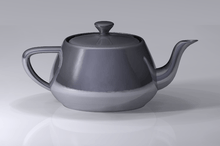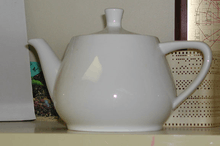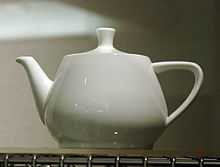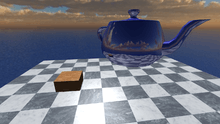Utah teapot

The Utah teapot or Newell teapot is a 3D computer model which has become a standard reference object (and something of an in-joke) in the computer graphics community. It is a mathematical model of an ordinary teapot of fairly simple shape, which appears solid, cylindrical and partially convex. A teapot primitive is considered the equivalent of a "hello, world" program, as a way to create an easy 3D scene with a somewhat complex model acting as a basic geometry reference for scene and light setup. Many programming libraries will even have functions dedicated to drawing teapots.[1]
The teapot model was created in 1975 by early computer graphics researcher Martin Newell, a member of the pioneering graphics program at the University of Utah.[2]
History
Newell needed a moderately simple mathematical model of a familiar object for his work. His wife Sandra Newell suggested modelling their tea service since they were sitting down to tea at the time. He got some graph paper and a pencil, and sketched the entire teapot by eye. Then he went back to the lab and edited bézier control points on a Tektronix storage tube, again by hand.


The teapot shape contains a number of elements that made it ideal for the graphics experiments of the time: it is round, contains saddle points, has a genus greater than zero because of the hole in the handle, can project a shadow on itself, and looks reasonable when displayed without a complex surface texture.
Newell made the mathematical data that described the teapot's geometry (a set of three-dimensional coordinates) publicly available, and soon other researchers began to use the same data for their computer graphics experiments. These researchers needed something with roughly the same characteristics that Newell had, and using the teapot data meant they did not have to laboriously enter geometric data for some other object. Although technical progress has meant that the act of rendering the teapot is no longer the challenge it was in 1975, the teapot continued to be used as a reference object for increasingly advanced graphics techniques.
Over the following decades, editions of computer graphics journals (such as the ACM SIGGRAPH's quarterly) regularly featured versions of the teapot: faceted or smooth-shaded, wireframe, bumpy, translucent, refractive, even leopard-skin and furry teapots were created.
The original teapot model was never intended to be seen from below and had no surface to represent the base of the teapot; later versions of the data set have fixed this.
The real teapot is noticeably taller (by a ratio of 4:3) compared to the computer model because Newell's frame buffer used non-square pixels. Rather than distorting the image, Newell's colleague Jim Blinn reportedly scaled the geometry to cancel out the stretching, and when the model was shared with users of other systems, the scaling stuck. This account was however later contradicted by Jim Blinn himself, who stated that he scaled the model on the vertical axis during a demo in the lab to demonstrate that they could manipulate it. They then liked the way this new version looked and saved the file.[3]
The original, physical teapot was purchased from ZCMI (a department store in Salt Lake City) in 1974. It was donated to the Boston Computer Museum in 1984 where it was on display until 1990. It now resides in the ephemera collection at the Computer History Museum in Mountain View, California where it is catalogued as "Teapot used for Computer Graphics rendering" and bears the catalogue number X00398.1984.[4]
Versions of the teapot model, or sample scenes containing it, are distributed with or freely available for nearly every current rendering and modelling program and even many graphic API, including AutoCAD, Houdini, Lightwave 3D, MODO, POV-Ray, 3ds Max, and the OpenGL and Direct3D helper libraries. Some RenderMan-compliant renderers support the teapot as a built-in geometry by calling RiGeometry("teapot", RI_NULL). Along with the expected cubes and spheres, the GLUT library even provides the function glutSolidTeapot() as a graphics primitive, as does its Direct3D counterpart D3DX (D3DXCreateTeapot()). However version 11 of DirectX does not provide this functionality anymore. Mac OS X Tiger and Leopard also include the teapot as part of Quartz Composer; Leopard's teapot supports bump mapping. BeOS included a small demo of a rotating 3D teapot, intended to show off the platform's multimedia facilities.
Teapot scenes are commonly used for renderer self-tests and benchmarks.[5][6]
Appearances
With the advent of first computer generated short films, and then of full-length feature films, it has become something of an in-joke to hide a Utah teapot somewhere in one of the film's scenes.[7] For example, in the movie Toy Story the Utah teapot appears in a short tea-party scene. The Utah teapot sometimes appears in the "Pipes" screensaver shipped with Microsoft Windows,[8] but only in versions prior to Windows XP, and has been included[9] in the "polyhedra" XScreenSaver hack since 2008. The teapot also appears in The Simpsons episode "Treehouse of Horror VI" in which Homer discovers the "third dimension".[10] It also appears in Pixar's Monsters, Inc. on the table in Boo's bedroom.
One famous ray-traced image (by Jim Arvo and Dave Kirk, from their 1987 SIGGRAPH paper "Fast Ray Tracing by Ray Classification") shows six stone columns, five of which are surmounted by the platonic solids (tetrahedron, cube, octahedron, dodecahedron, icosahedron). The sixth column supports a teapot.[11] The image is titled "The Six Platonic Solids" – which has led some people to call the teapot a "Teapotahedron". This image appeared on the covers of several books and journals. Jim Blinn (in one of his "Project MATHEMATICS!" videos) proves an amusing (but trivial) version of the Pythagorean theorem: Construct a (2D) teapot on each side of a right triangle and the area of the teapot on the hypotenuse is equal to the sum of the areas of the teapots on the other two sides.
The teapot also makes an appearance in the Technology Test level of the Serious Engine, where it is used to demonstrate many of the engine characteristics.
In addition, the teapot is a spawnable object in the astronomical physics simulator Universe Sandbox, more-or-less to scale with the other entities in the program. Its presence may be a reference to Bertrand Russell's "cosmic teapot" analogy.
In Autodesk’s Inventor 2013, the function for rendering (both Render Image and Render Animation) includes icons that depict the teapot.
3D printing
The Utah Teapot has come full circle from being a computer model based on an actual teapot to being an actual teapot based on the computer model. It is widely available in many renderings in different materials from small plastic knick-knacks to a fully functional ceramic teapot. It is sometimes intentionally rendered as a blocky, low poly object to celebrate its origin as a computer model.
Gallery
|
See also
- 3D modeling
- Stanford Bunny
- Suzanne (3D model)
- Cornell Box
- List of common 3D test models
- Lenna
References
- ↑ "glutSolidTeapot". Glut. Retrieved October 7, 2011.
- ↑ Torrence, Ann (2006). "Martin Newell's original teapot ". Siggraph '06. New York: ACM. p. 29. doi:10.1145/1180098.1180128. ISBN 1-59593-364-6. Article No. 29. (see ACM Digital Library reference )
- ↑ Seymour, Mike (2012-07-25). "Founders Series: Industry Legend Jim Blinn". fxguide.com. Archived from the original on 2012-07-29. Retrieved 15 April 2015.
- ↑ "Original Utah Teapot at the Computer History Museum". The Computer History Museum. 2001-09-28. Archived from the original on 2012-08-20. (The date for the teapot itself was ca. 1974)
- ↑ Wald, Ingo; Carsten Benthin; Philipp Slusallek (2002). "A Simple and Practical Method for Interactive Ray Tracing of Dynamic Scenes". Technical report, Computer Graphics Group (Saarland University). CiteSeer=http://citeseer.ist.psu.edu/wald02simple.html. Archived from the original on 2012-03-23.
- ↑ Klimaszewski, K.; Sederberg, T.W. (1997). "Faster ray tracing using adaptive grids". IEEE Computer Graphics and Applications 17 (1): 42–51. doi:10.1109/38.576857.
- ↑ "Tempest in a Teapot". Continuum Magazine. Winter 2006–2007. Archived from the original on 2014-07-12.
- ↑ "Pipes" screensaver spec
- ↑ Xscreensaver changelog
- ↑ Groening, Matt. "Pacific Data Images on Homer³ (The Simpsons Halloween Special)". Archived from the original on 2000-10-18.
- ↑ Carlson, Wayne (2007). "A Critical History of Computer Graphics and Animation". OSU.edu. Archived from the original on 2012-02-12. Retrieved 15 April 2015.
External links
| Wikimedia Commons has media related to Utah teapot. |
| ||||||||||||||||||||||||||||||

